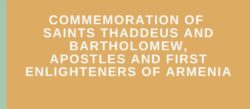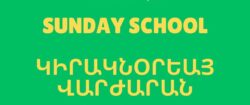GREAT LENT BEGINS ON March 3
This year, the Armenian Church calendar designates Monday, February 20, as the first day of Great Lent: the season when Christians consciously turn away from worldly matters and make the effort–through prayer, fasting, study, and introspection–to prepare for the spiritual drama of Holy Week and Easter Sunday.
The Scriptural basis for Lent resides in the 40-day period Christ spent in the wilderness following his baptism. In the words of St. Matthew’s Gospel (4:12): “Then Jesus was led up by the Spirit into the wilderness to be tempted by the devil. And he fasted forty days and forty nights, and afterward he was hungry.”
During Lent we are called to follow the Holy Spirit to confront our own “inner wilderness”–the realm of spiritual emptiness engendered by sin, laziness, and vanity. Through prayer, fasting, Bible-reading, and self-examination, we are given an opportunity to renew our commitment to God, and gain the strength to work at being more loving, humble, and gentle.
ՄԵԾ ՊԱՀՔԸ ԿԸ ՍԿՍԻ ԵՐԿՈՒՇԱԲԹԻ, 3 ՄԱՐՏԻ
Բուն Բարեկենդանը կը նշէ Մեծ Պահքի շրջանը, սակայն պահեցողութիւնը կը սկսի Երկուշաբթի, 20 Փետրուարին։ Մեծ Պահքը եկեղեցական տօնացոյցի պահքի ամենէն երկար շրջանն է, որ կը տեւէ 40 օր, մինչեւ Ղազարի յարութեան տօնը, որ Ծաղկազարդի նախորդող Շաբաթ օրն է, որուն կը յաջորդէ Աւագ Շաբաթը։
Բուն Բարեկենդանը հաւատացեալները կ՚առաջնորդէ դէպի Մեծ Պահքի շրջանը։
Մեծ Պահքը՝ աղօթքի, պահեցողութեան եւ բարեպաշտութեան ժամանակաշրջան մը ըլլալով, խիստ անձնական հոգեկան ճամբորդութիւն մըն է, որուն հիմքը Քրիստոսի անապատին մէջ անցուցած քառասուն օրերու շրջանն է՝ Մկրտութենէն ետք։ Ինչպէս կը կարդանք Աւետարանին մէջ, «յետոյ Յիսուս Սուրբ Հոգիին կողմէ տարուեցաւ անապատ՝ Սատանայէն փորձուելու համար: Քառասուն օր եւ քառասուն գիշեր ծոմապահութեամբ անցընելէ ետք՝ անօթեցաւ» (Մտ 4.1-2)
Great Lent in the Armenian Church
Great Lent (Arm. Medz Bahk, Մեծ Պահք), is also called “Karasnortk” since it lasts forty days. The days of lent are referred to as Karasnortagan and the Sundays- Karasnortagan Giragi. Great Lent is the longest of the fasts prescribed in the liturgical calendar and it begins on the Monday following Poon Paregentan and lasts for forty days (six weeks) up until the Friday prior to Lazarus Saturday. Great Lent is therefore the preparatory spiritual journey with its destination of Easter, “the Feast of Feasts.” It is the preparation for the “fulfillment of Pascha, the true Revelation.”
Liturgical structure of Lent
Lent originated in the very earliest days of the Church as a preparatory time for Easter, when the faithful rededicated themselves and when catechumens were instructed in the faith and prepared for baptism. By observing the forty days of Lent, the individual Christian imitates Jesus’ withdrawal into the wilderness for forty days and rededicates himself to the church through prayer, fasting and learning (Matt. 4:2).
To understand the various liturgical particularities of the Lenten period, we must remember that they express and convey to us the spiritual meaning of Lent and are related to the central idea of Lent, to its function in the liturgical life of the Church it is the ideal of repentance. In the teaching of the Armenian Church however, repentance means much more than a mere enumeration of sins and transgressions to the priests. Confession and absolution are but the result, the fruit, the “climax” of true repentance. And, before this result can be reached, becoming truly valid the meaningful, one must make a spiritual effort- go through a long period of prepa
ration and purification. Repentance means a deep, radical reevaluation of our whole life, of all our ideas, judgments, worries, mutual relations, etc. It applies not only to some “bad action,” but also to the whole of life. At every moment of life, but especially during Great Lent, the Church invites the penitent to concentrate attention on the ultimate values and goals, to measure life by the criteria of Christian teaching, to contemplate human existence in its relation to God. This is repentance and it consists therefore, before everything else, in the acquisition of the Spirit of repentance, i.e., of a special state of mind, a special disposition of our conscience and spiritual vision. The Lenten worship is thus a school of repentance. It teaches us what repentance is and how to acquire the spirit of repentance. It prepares us for and leads us to the spiritual regeneration, with which “absolution” remains meaningless. It is, in short, both teaching about repentance and the way of repentance. And, since there can be no real Christian life without repentance, without this constant “reevaluation” of life, the Lenten worship is an essential part of the liturgical tradition of the Church. The neglect of it, its reduction to a few purely formal obligations and customs, and the deformation of its basic rules constitute one of the major deficiencies of Church life today.
Armenian Lenten Services
The Peace Service, Rest Service and Sunrise Service are performed more often during Great Lent than at other times of the year. (Usually, Peace and Rest Services are performed only on Friday evenings.) These three services are part of the Church’s cycle of seven daily worship services but are of particular significance during Great Lent because they are penitential in nature and remind us of the effort we are making to restore our pure and joyous relationship with God.
The evening Peace Service consists of prayers for peace to end each day. These prayers remind us that God is with us even in the face of trial and temptation.
The Rest Service, which comes just before retiring for the night, asks God’s continuing care through the night. It includes the prayer of St. Nersess.
The Sunrise Service, performed first thing in the morning, reminds us that God is the giver of the light of morning and the light of salvation. Its beautiful prayers and hymns reflect the fresh and serene quality of the most beautiful time of day. This service is performed in our churches before or after Sunday morning liturgy.
Click here for the schedule of 2018 Lenten Services
FREQUENTLY ASKED QUESTIONS ABOUT GREAT LENT
Why does our Lent begin on Monday instead of Ash Wednesday?
All the ancient churches observe Lent (Medz Bahk, meaning “Big Fast”) over a period of forty days. The Latin name Quadragesima corresponds to the Armenian Karasnortats Bahk (‘Fast of Forty Days’). The traditions differ in how to calculate the forty-day period.
In the Western Church Lent originally began six weeks before Easter. Since Sundays during that period were not fasting days, the Quadragesima was four days short. As a result, four days were later added and the beginning of Lent was set on Ash Wednesday, which is six-and-a-half weeks before Easter.
In the Eastern churches the forty-day period is calculated differently. Holy Week, which immediately precedes Easter and is a period of fasting, is not included as a part of Lent but as a separate unit of time. Lent in our tradition begins six weeks prior to Palm Sunday, and is actually of forty-two days duration. The first Sunday of Lent is Poon Paregentan (‘Good-living Day’). All the curtains in church must be closed on the Saturday evening preceding Poon Paregentan.
How many days does Lent last in the Armenian Church
In the entire Christian East, including Armenia, Lent begins on the 7th Monday before Pasha. This was already mentioned by St. Athanasius in his festal letters (4th century.) So for the Armenians, Lent begins on a Monday, and lasts exactly 40 days (but it was not always so?)
For the Armenian Church Great Lent ends on the Friday before Palm Sunday. That is the 40th day. The next day is Lazarus Saturday (the 41st. day). In the Christian East Lent does not include Holy Week, which begins on the Monday after Palm Sunday.
But beware. Forty days of Lent does not necessarily mean forty days of fasting since Saturday and Sunday were not traditionally considered fasting days in the Armenian Church. Saturdays during Lent are devoted to saints? commemorations, and Sunday is always the Day of the Lord, when fasting was considered not only unwarranted, but prohibited! We do not fast when the bridegroom is present [Matthew 9:15]. Over the centuries, however, the overwhelming penitential spirit of Lent influenced the popular piety of the Armenian people. It became the custom to extend the Lenten fast also to Saturdays and Sundays, contrary to the ancient tradition.
When did Lent originate?
The earliest potential reference to Great Lent is in Canon 5 of the Council of Nicea (325 AD). The Greek phrase, pros tessarakostys which means ?before the fortieth.? This could refer to Easter as the summit of a forty-day fast, or, equally possibly, to the Ascension, the fortieth day after Easter.
The first indisputable reference to Great Lent is from St. Athanasius, the great theologian-bishop of Alexandria (died 373 AD). In one of his ?festal letters,? which announced the date of Easter each year to all the churches of the world, he speaks of a 40-day Fast beginning the sixth week before Easter and including ?Holy Week,? which he called ?Holy Paschal Week.? This is a week of more intensive fasting, vigils, etc., in preparation for Pascha.
By 340 AD Lent is universal. By 384 AD, we have clear evidence that Lent is fully developed in Jerusalem, with a cycle of liturgical services. This evidence comes to us from the diary of the Spanish nun Egeria, who made a pilgrimage to the Holy Land in 384 and took copious notes about what she saw, especially the liturgical life.
How did Lent originate?
There are two theories on the Origin of Lent:
1. Lent was originally a 40-day Post-Epiphany Fast modeled after Christ?s journey into the desert following his baptism. These forty days gradually became joined to Pascha. There is some evidence for this connection of Lent to Epiphany in Egypt. Recently, however, liturgical scholars have cast doubt on this theory.
2. The scholarly consensus favors the theory that Lent developed from a 40-day catechumenate in preparation for baptism on Pascha. The North-African theologian Tertullian (c. 225 AD) refers to vigils and fasts in preparation for Paschal baptism. (See Romans 6, which envisions baptism as dying and rising with Christ. Throughout the Christian world, Easter became the preferred time to conduct baptism.) Gradually this developed into a formalized period of catechetical instruction for candidates for baptism. In time, baptized members of the church also participated in this pre-baptismal instruction.
The Armenian Church has an ancient service conducted on Holy Thursday called the ?Absolution (or Dismissal) or the Penitents.? It is a long ceremony of scripture readings, hymns, and beautiful prayers of forgiveness. This service may well have its roots in the early centuries of the Church, when the faithful joined the catechumens in a ceremony of confession and absolution in preparation for Easter. Only the Latin rite has an analogous service on Holy Thursday.
Lent probably developed from a fusion of the 40-day catechumenate with the fast that preceded Pasha. This fast preceding Easter was originally one day (Saturday), but it soon developed into two and then three days.
The Council of Laodacea (mid-4th C.) provides the first legislation regarding the Catechumenate period. There can be no matrimony, no martyrs? commemorations during Lent (Except Saturday and Sunday) There is fasting every day.
Are there exactly forty days in Great Lent?
The names for Lent in Latin, Greek, Armenian and other ancient languages all somehow convey the idea of “forty”?
Latin= Quadragesim
Greek = Tessarakosta
Armenian = Karasnortk
But the idea that Great Lent should have exactly 40 days, no more, no less, is a later, medieval notion. In the Bible as in the Early Church, the number ?forty? had theological, not mathematical significance. Forty is a number that implies completeness, fullness, the total time necessary to complete a given mission fully and completely. When the Evangelist states that Jesus spent 40 days and 40 nights in the desert, he doesn?t mean to stipulate how many times the sun rose and set. He is implying, according to the religious-literary conventions of his time, that Jesus spent a good period of time in the desert, enough to accomplish that which was required of him by God. The same can be said for Noah in his ark, Moses on Mount Sinai, and the Jews in the wilderness.
Throughout the Christian world (which includes Armenia, of course), the exact number of days in Lent differed greatly from place to place and century to century, even if the name for ?Lent? in many ancient languages implies ?forty.? It was only later that the churches began to make adjustments to their liturgical calendars in order to ensure that the fasting period consisted of exactly forty days.
What are some other Armenian words for Great Lent?
Other words for “Lent” in Armenian are:
Medz Bahk = Մեծ Պահք = Great Lent
Aghoohats = Աղուհաց = “salt and bread” (long with water, that is ALL one traditionally eats during the fasting days of Lent.
Materials used:
Very Rev. Fr. Krikor Maksoudian, “Frequently Asked Questions about The Armenian Church”
V. Rev. Fr. Daniel Findikyan, “Frequently Asked Questions about Great Lent”
Alexander Schmemann, “Great Lent: Journey to Pascha”
















